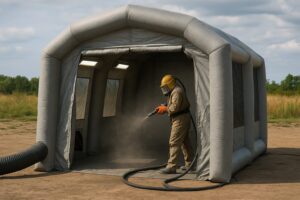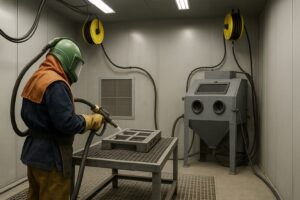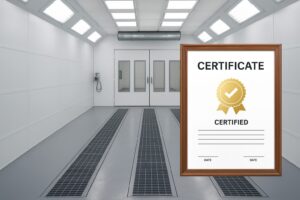Maintaining optimal airflow in your paint booth is crucial for a variety of reasons: it ensures a smooth finish on your work, prevents the buildup of harmful fumes, and promotes a safer, more efficient working environment. Achieving the perfect airflow requires attention to detail and regular maintenance to keep your paint booth operating at its best. Let’s dive into the key factors to consider and how to keep your booth’s airflow system in top shape.
It’s important to understand why airflow is so essential in a paint booth. When painting, especially with spray guns, you release a fine mist of paint particles into the air. These particles need to be efficiently captured and filtered to prevent them from settling on surfaces, creating imperfections. Moreover, improper airflow can lead to the buildup of dangerous chemicals in the air, which could lead to health risks for workers. A properly ventilated paint booth removes these harmful fumes, maintains a clean environment, and ensures that the final product looks as flawless as possible.
1. Check Filters Regularly
The heart of any paint booth’s airflow system is its filtration. Your intake filters keep dust and other particles from entering the booth, while the exhaust filters capture the paint overspray. Over time, these filters can become clogged with debris, which impedes airflow and reduces the efficiency of the system. When filters are clogged, the airflow becomes uneven, which could result in uneven paint finishes or, in worst-case scenarios, the booth becoming unsafe to use due to poor ventilation.
Regularly check the filters, and make sure they’re clean or replaced according to the manufacturer’s recommendations. For high-volume booths, you may need to replace filters more frequently to ensure that the air entering the booth is clean and the exhaust system is working efficiently.
2. Maintain Exhaust Fans
Exhaust fans play a key role in removing the overspray and fumes from the booth. If the exhaust fans aren’t working properly, the air inside the booth will become stagnant, leading to poor paint finishes and unsafe working conditions. Ensure that the exhaust fans are running at optimal speed and that there are no obstructions in the ducts. If you notice that the exhaust isn’t as strong as it should be, it may be time to clean the fans or even replace them if necessary.
Exhaust fans should be inspected regularly, and they must be adjusted to maintain a consistent airflow. If your fans are adjustable, make sure they’re set at the appropriate levels for the booth’s size and the volume of paint being applied.
3. Proper Booth Sealing
Another factor that can impact the airflow in your paint booth is how well it’s sealed. Any gaps or cracks in the booth can disrupt the flow of air, causing uneven airflow and allowing dust, dirt, or other contaminants to enter the booth. Check the seals on doors, windows, and walls to ensure there are no leaks. Seals and gaskets should be replaced when worn out to maintain proper airflow.
A well-sealed booth also helps to control the pressure inside the booth, which can impact the quality of the finish on your work. If your booth’s pressure is too low, contaminants can enter, and if the pressure is too high, it can affect the airflow rate. A consistent airflow at the right pressure is key to ensuring smooth and flawless finishes.
4. Monitor Airflow Velocity
Airflow velocity refers to how quickly air moves through the booth. Too little airflow can lead to problems like overspray and poor ventilation, while too much airflow can disrupt the even distribution of air and lead to issues like dirt contamination. Maintaining the right balance is important to ensure the quality of both your work and the air quality in the booth.
You can use a manometer or an airflow gauge to monitor the velocity of the air in the booth. These tools can help you assess whether the airflow is at the correct level and whether adjustments are needed. Aim to keep the velocity at the recommended level set by the manufacturer, as this will ensure optimal airflow and a safe working environment.
5. Clean and Maintain Ductwork
Over time, ducts in the paint booth can accumulate paint dust, grease, and other debris. This buildup can hinder airflow, reduce the efficiency of your exhaust system, and even pose a fire hazard. Regularly cleaning the ducts and inspecting them for any damage or blockages is essential for maintaining airflow.
Ensure that the ducts are properly insulated to maintain temperature control, as this can also affect airflow. If you notice any cracks or damage in the ductwork, these should be repaired or replaced immediately to avoid disrupting the airflow system.
6. Control Temperature and Humidity
Temperature and humidity levels play a significant role in both the quality of the paint job and the airflow in the booth. High humidity can cause the paint to dry too slowly, leading to imperfections and an increased risk of contamination. On the other hand, excessively dry conditions can cause the paint to dry too quickly, leading to a rough finish.
Make sure your paint booth is equipped with the necessary systems to control both temperature and humidity. This will ensure the paint flows smoothly and evenly, reducing the chances of imperfections. These systems should also help maintain the airflow by preventing condensation, which could clog filters and ducts.
7. Regular Maintenance Schedule
Establishing a regular maintenance schedule is one of the most effective ways to ensure the optimal performance of your paint booth’s airflow system. This includes not only checking filters and exhaust fans but also performing in-depth inspections of all components, such as seals, ducts, and airflow monitors.
A well-maintained booth will run more efficiently, ensuring that the air remains clean and that the booth operates at peak performance. Establishing a checklist for maintenance tasks and sticking to a regular schedule will help catch potential issues before they turn into bigger, more costly problems.
8. Training Staff on Airflow Importance
Finally, it’s important to train your staff on the significance of maintaining optimal airflow. Workers should understand the proper procedures for operating the paint booth and how to spot signs of airflow problems. This can help prevent unnecessary downtime and ensure that everyone is working safely. Regular training and awareness will ensure the longevity and efficiency of your paint booth.
By following these steps and maintaining a routine of checks and servicing, you can ensure that your paint booth runs smoothly and efficiently. Whether you’re spraying cars, furniture, or any other products, optimal airflow ensures that the paint job is flawless, the air quality is safe, and your equipment remains in top condition.
How We Can Help with Your Paint Booth Needs
At Paint Booth, we specialize in providing top-tier paint booths and finishing equipment tailored to your business requirements. Whether you need a standard-size paint booth or a custom solution designed for your unique projects, our expert team is here to assist you every step of the way. From design to installation, we ensure that your equipment meets the highest industry standards, enhancing both your productivity and the quality of your finishes. Contact us today to find the perfect paint booth solution for your business!




